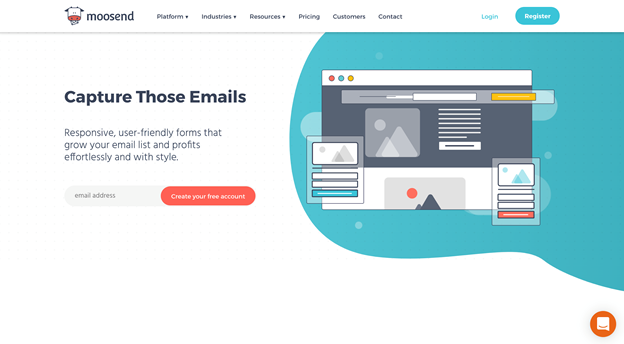There is so much more that needs to go into a successful content marketing strategy than just blog posts and lead magnets. In order to really ramp up your lead generation, it’s time to start experimenting with interactive content.
With the dozens of online tools available to help you get more creative with your content, it’s time to invest in interactivity and learn how to get more leads with engaging, interactive content.
What is Interactive Content?
Interactive content can take all sorts of shapes and forms, but it’s essentially content that creates an experience for your audience to interact or engage with.
Think about that interactive Black Mirror episode on Netflix, and how new and exciting it was to use your remote to choose the storyline.
Interactive content on your website can have the same effect on your audience, helping you to generate even more leads and close even more sales.
Types of Interactive Content
Now that we’ve provided a basic introduction into what interactive content is, let’s dig into the finer details by discovering specific types of interactive content your brand could be creating and sharing with its audience.
Diagrams/Infographics
Did you know that diagrams and infographics can be interactive? By using a tool like Visme, which provides infographic templates, interactive charts and maps, and embedment options, you can create and share your own interactive diagrams and infographics.

Interactive diagrams showcase data that can be hovered over or clicked on to view more information, whether it’s in the form of a bar graph, map, what have you.
By incorporating animated elements, you can increase the level of engagement that these pieces of content provide your audience, and even embed sign-up forms from an email marketing platform like Moosend or SendX to help you generate leads right inside your content.

Wow your audience with interactive data visualizations and consider emailgating some of your interactive content to help generate even more leads.
Polls
Another great type of interactive content to create that can also help you gather customer feedback in a more fun and engaging way is polls. We see these being used regularly in Instagram Stories and Twitter posts, but you can also take advantage of this on your website.
You can use polls within a blog post or on a webpage to ask your audience random questions relevant to your industry, or to ask strategic queries about potential product or feature releases and gauge interest.
Take advantage of polling tools like SurveyMonkey to create online polls that you share and watch results come in in real time.

Another unique polling tool is Slido, which allows you to create live polls to share during webinars or presentations and ask your audience to get out their phones and vote while they’re right there viewing your content. This is a creative ice breaker tactic when speaking to larger groups of people.
Quizzes/Assessments
Putting together quizzes and assessments to accompany blog posts can be a great way to bring in more readers and generate more brand awareness.
Consider something like this – you’ve written a stellar blog post that talks all about the different presentation styles. But you don’t want to stop there.
So you also create a quiz that your readers can take to help them determine their own presentation style based on the answers they select.
Similar to the Meyers-Briggs and Enneagram assessments, these help your readers come away from your blog post, not just learning about presentation styles, but also learning something about themselves.
You can use tools like SurveyAnyplace or KyLeads to create various quizzes, assessments, questionnaires and more.

Interactivity like this is designed to bring a more authentic experience to your audience, and in turn, creating more interest in your brand.
If you want to take this even further, consider chatbots such as Tidio. This relatively technology is the essence of interactivity. In fact, best chatbots can serve as quizzes, questionnaires and polls all in one. With their increasing popularity, chatbots are slowly becoming one of the most effective and desired forms of interactive content.
Videos
We’re not talking about regular videos that you film and share on YouTube for your audience to sit and watch.
Nope, we’re talking interactive, choose your own path, point of view videos that actually make your audience feel like they’re involved in the video.
There are many different types of interactive videos that can be used in a variety of ways, from showcasing different views of a product to creating a gamified experience where viewers have to make decisions based on what they’ve watched.
While these are a bit trickier to create, businesses like Rapt Media are helping to create these for a variety of different use cases, including this Deloitte recruitment campaign below.

Interactive videos can create unique experiences for your website visitors that will make them excited to share your business with others.
Calculators
Want to provide some real value for your website visitors? Create interactive calculators that allow users to input various information to get an actual, incredibly helpful answer.
Here’s a great example of a few useful calculators for startups from SpdLoad. They’ve created salary calculators, outstaff calculators, and project calculators to help startup founders get tangible numbers for various business expenses.

Consider what types of calculators your business could offer on your website that are relevant to your products or services and could provide hard numbers and real value to your potential customer.
You might have to work with a developer to put this into play, but the ROI generated from providing a service like this to your audience for free – or in exchange for an email address – will likely be worth it.
Tools
Another type of interactive content that you may need to invest in a developer for is a tool or generator that you host on your website that helps your website visitors do something.
One of our favorite examples of this has been done by Bid4Papers. Their thesis statement generator is the perfect complementary tool to their paper writing service, allowing students to input certain information and getting a fully put together thesis statement in return.

Another great example comes from Canva, a graphic design software, that provides tools like a font pair generator, an interactive color wheel, and this color palette generator featured below.

All of these free tools are complementary to the actual service they offer and can even be used hand-in-hand with their software.
How to Use Interactive Content for Lead Generation
Now that we’ve covered six essential types of interactive content you should start creating and offering on your website, let’s dive into the strategies that you need to implement to ensure your leads start rolling in.
1. Place a lead generation form within the interactive content.
Like I mentioned earlier when talking about interactive diagrams and infographics, many types of interactive content give you the ability to place your lead generation forms directly within your content.
You can use a call-to-action like, “Sign up to see more content like this,” and then add your new leads to a CRM like Hubspot or Pipedrive.

Then you can start sending out sales and marketing emails to help nurture your new leads further down your sales pipeline.
2. Send quiz or assessment results by email.
Another idea to increase lead generation through your interactive content is to create and promote quizzes and assessments on your website or in blog posts, allow your audience to take the test for free, then send their results by email.
Back to the Meyers-Briggs personality test, the site 16Personalities does something similar by showcasing results on their website, but also offering to email them to test takers so they can save their results and refer back to them later.

You can use this for quizzes, assessments, calculators and more. You could even have a place for people to insert their email address to receive poll results as well once you’ve gathered them all and analyzed them.
3. Require an email sign-up for more content.
This is similar to the last point but can be done for more use cases as well. In this case, you can provide a sneak peek of the details or results, then ask for an email address to send over the full report, results, analysis, etc.
You can then add all of the email addresses to your marketing pipeline and use a tool like UpLead or AeroLeads to ensure you’ve got the best contact information and highest quality sales leads.

4. Require users to sign up before accessing your interactive content.
One tactic for using interactive content to help increase your sales leads is to completely restrict access until your website visitor inputs their email address into a form.
This is called emailgating your interactive content, and should be reserved for the most valuable, bottom-of-the-funnel content.
You only want to use this for bottom-of-the-funnel content because someone who is just learning about your business and has stumbled across your interactive content or tool isn’t likely to give you their email address just to access your content.
They’re more likely to submit their email address after using your content, whereas a lead who is already well acquainted with your business and the value you provide will be happy to sign up simply to access your free tool or content.
Taking advantage of a tool like LiveSession can help you analyze your website visitors’ behavior to see if this method is effective for your business or not.

5. Include a signup form alongside results.
Instead of gating any content or requiring an email signup, you might want to simply provide as much free value to your potential customer as possible and rely on their trust in your business to want to hear more from you.
In this instance, simply placing a signup form alongside results with a compelling call-to-action can be a great way to request that new leads follow along with your business.
You can further rope new subscribers in by sending an enticing welcome email that shares even more valuable resources from your website. Use a tool like Mailtrap to test your email deliverability and ensure your email content looks and works perfectly.
6. Promote your interactive content.
If you want more leads, you need more people accessing your interactive content. This means you need to promote it! You can do so easily by sharing your content on social media, interlinking to it on your website, promoting it in email newsletters and more.
A tool like Adzooma can be a huge help in creating effective ads that target the perfect demographic for your business and interactive content.

You can also use Hrefshare to generate links to your content and encourage those who use or view your interactive content to easily share it as well.
Make sure you create captivating copy to go along with your ads, social media posts, emails and more, to help bring in as many new users as possible. The more people who access your content, the higher the chances they send you their email address and start down the customer journey.
Start Getting More Leads With Interactive Content
Ready to start creating engaging and dynamic interactive content for your brand? There are so many tools to help you create and promote your content and start funneling new sales leads into your pipeline, so don’t wait to get started.
Be sure to utilize SuperMonitoring’s features to ensure that your web pages with interactive content are always live and functioning properly.
About the Author

Chloe West is a digital marketer and freelance writer, focusing on topics surrounding social media, content, and digital marketing. She’s based in Charleston, SC, and when she’s not working, you’ll find her at brunch or hanging out with her son.



